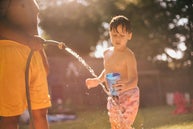
INTEGRATED CURRICULUM (STEM, STEAM, STREAM, STEMIE)
Introduction
Holistic, interdisciplinary learning is promoted by integrated curriculum models like STEM (Science, Technology, Engineering, Mathematics), STEAM (adding Arts), STREAM (adding Reading), and STEMIE (adding Invention & Entrepreneurship). Through practical projects, these frameworks enable children to make connections between their knowledge in various topic areas. Integrated approaches in early childhood foster critical thinking, creativity, and problem-solving skills. The EYLF places a strong emphasis on integrated learning experiences that mirror how children learn best—through play, experimenting, and exploration. Children are prepared for lifelong learning and flexibility by working on projects that integrate various disciplines. This fosters flexible thinking and the ability to apply knowledge creatively in real-world situations.
Theories and Views of Creativity
Given that children build knowledge by making, Papert's constructionism is highly compatible with integrated learning. In multidisciplinary initiatives, Vygotsky's sociocultural theory encourages cooperation and group problem-solving. Piaget's constructivism places a strong focus on experiential learning as the cornerstone of learning in all subject areas. A key component of STEM/STEAM projects, the design thinking methodology promotes empathy, ideation, prototyping, and iteration. Csikszentmihalyi's "flow" condition is frequently seen when performing integrated, immersive tasks. Children can solve complicated problems and create in meaningful, age-appropriate ways thanks to integrated curricular methods, which combine knowledge from science, technology, engineering, the arts, reading, and mathematics.


Materials, Digital Technologies, and Resources
Building kits, robotics sets, painting supplies, measurement devices, and recycled materials are examples of the flexible resources needed for integrated learning. Multidisciplinary projects are supported by digital technologies such as design software, coding apps, and tablets. Creative possibilities are expanded with 3D printers and makerspace equipment. For STEAM projects, art and narrative can be paired with science kits, microscopes, and nature exploration instruments. STEM topics are linked to literacy in books and online resources. Projects can be guided from planning to testing with the use of design thinking templates. There are chances for environmental STEM initiatives in outdoor areas. Video, audio, and photography are examples of recording methods that facilitate reflection and presentation, demonstrating learning across several subject areas.
Experiences in Learning

0-2 Years
Water and Light Play: Using art (light reflection) and science (water characteristics) to explore the senses.
Stack and Roll Structures: Investigate engineering and cause-and-effect using blocks and balls.

2-3 Years
- Shape Printing: Making artwork while talking about geometry.
- Magnet Painting: This technique combines creativity and science by using magnets to move items covered in paint.

3-5 Years
- Garden Design Project: This project combines art, math, and science to design and create a garden.
- Story-Based STEM Challenge: Creating answers to problems faced by fictional characters.

6-8 Years
- Bridge-Building Contest: using technology, engineering, and mathematics to create robust bridges.
- Inventors' Fair: Creating presentations, marketing collateral, and prototypes for new ideas.
Create Your Own Website With Webador